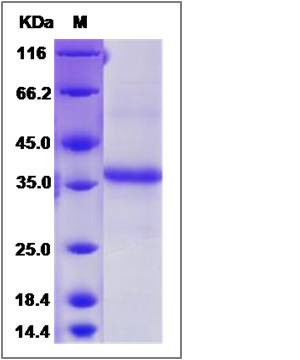Human CLDN11 / Claudin-11 Protein (Fc Tag)
OSP,OTM
- 100ug (NPP2021) Please inquiry
| Catalog Number | P12903-H04H |
|---|---|
| Organism Species | Human |
| Host | Human Cells |
| Synonyms | OSP,OTM |
| Molecular Weight | The recombinant human CLDN11/mFc comprises 296 amino acids and has a predicted molecular mass of 33.2 kDa. The apparent molecular mass of the monomer is approximately 37 kDa in SDS-PAGE under reducing conditions due to glycosylation. |
| predicted N | Asp |
| SDS-PAGE |  |
| Purity | > 90 % as determined by SDS-PAGE |
| Protein Construction | A DNA sequence encoding the human CLDN11 (O75508) (Val23-Arg82) was expressed with the Fc region of mouse IgG1 at the N-terminus. |
| Bio-activity | |
| Research Area | Cancer |Signal transduction |Cytoskeleton / ECM |Cell Adhesion |Claudin |
| Formulation | Lyophilized from sterile PBS, pH 7.4 1. Normally 5 % - 8 % trehalose, mannitol and 0.01% Tween80 are added as protectants before lyophilization. Specific concentrations are included in the hardcopy of COA. |
| Background | Claudin-11, also known as CLDN11, belongs to the group of claudins. Claudins are integral membrane proteins and components of tight junction strands. Tight junction strands function as a physical barrier to prevent solutes and water from passing freely through the paracellular space between epithelial or endothelial cell sheets, and also play critical roles in maintaining cell polarity and signal transductions.Claudin-11 is a tight junction associated protein and is a major component of central nervous system (CNS) myelin that is necessary for normal CNS function. Human blood-testis barrier disruption is related to a dysfunction of CLDN11 gene. It plays an important role in regulating proliferation and migration of oligodendrocytes. |
| Reference |
